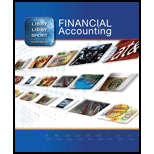
Financial Accounting, 8th Edition
8th Edition
ISBN: 9780078025556
Author: Robert Libby, Patricia Libby, Daniel Short
Publisher: McGraw-Hill Education
expand_more
expand_more
format_list_bulleted
Question
Chapter 2, Problem 6MCQ
To determine
Identify which of the given option describes how assets are listed on the
Expert Solution & Answer
Want to see the full answer?
Check out a sample textbook solution
Students have asked these similar questions
Please provide the solution to this general accounting question using proper accounting principles.
Can you solve this general accounting problem using accurate calculation methods?
Can you explain this financial accounting question using accurate calculation methods?
Chapter 2 Solutions
Financial Accounting, 8th Edition
Ch. 2 - Prob. 1QCh. 2 - Define the following: a. Asset b. Current asset c....Ch. 2 - Prob. 3QCh. 2 - Why are accounting assumptions necessary?Ch. 2 - For accounting purposes, what is an account?...Ch. 2 - What is the fundamental accounting model?Ch. 2 - Prob. 7QCh. 2 - Explain what debit and credit mean.Ch. 2 - Prob. 9QCh. 2 - Prob. 10Q
Ch. 2 - Prob. 11QCh. 2 - Prob. 12QCh. 2 - How is the current ratio computed and interpreted?Ch. 2 - Prob. 14QCh. 2 - Prob. 1MCQCh. 2 - Which of the following is not an asset? a....Ch. 2 - Total liabilities on a balance sheet at the end of...Ch. 2 - The dual effects concept can best be described as...Ch. 2 - The T-account is a tool commonly used for...Ch. 2 - Prob. 6MCQCh. 2 - The Cash T-account has a beginning balance of...Ch. 2 - Prob. 8MCQCh. 2 - At the end of a recent year, The Gap, Inc.,...Ch. 2 - Prob. 10MCQCh. 2 - Prob. 1MECh. 2 - Matching Definitions with Terms Match each...Ch. 2 - Identifying Events as Accounting Transactions...Ch. 2 - Classifying Accounts on a Balance Sheet The...Ch. 2 - Prob. 5MECh. 2 - Prob. 6MECh. 2 - Prob. 7MECh. 2 - Prob. 8MECh. 2 - Prob. 9MECh. 2 - Prob. 10MECh. 2 - Prob. 11MECh. 2 - Prob. 12MECh. 2 - Prob. 13MECh. 2 - Prob. 1ECh. 2 - Prob. 2ECh. 2 - Prob. 3ECh. 2 - Prob. 4ECh. 2 - Determining Financial Statement Effects of Several...Ch. 2 - Prob. 6ECh. 2 - Prob. 7ECh. 2 - Analyzing the Effects of Transactions In...Ch. 2 - Prob. 9ECh. 2 - Prob. 10ECh. 2 - Prob. 11ECh. 2 - Prob. 12ECh. 2 - Prob. 13ECh. 2 - Prob. 14ECh. 2 - Prob. 15ECh. 2 - Prob. 16ECh. 2 - Inferring Typical Investing and Financing...Ch. 2 - Prob. 18ECh. 2 - Prob. 19ECh. 2 - Prob. 20ECh. 2 - Identifying Accounts on a Classified Balance Sheet...Ch. 2 - Prob. 2PCh. 2 - Prob. 3PCh. 2 - Prob. 4PCh. 2 - Prob. 5PCh. 2 - Prob. 6PCh. 2 - Prob. 1APCh. 2 - Prob. 2APCh. 2 - Prob. 3APCh. 2 - Prob. 4APCh. 2 - Prob. 1CPCh. 2 - Prob. 2CPCh. 2 - Prob. 3CPCh. 2 - Prob. 4CPCh. 2 - Prob. 5CPCh. 2 - Prob. 6CPCh. 2 - Prob. 7CPCh. 2 - Prob. 8CPCh. 2 - Prob. 1CC
Knowledge Booster
Similar questions
- Can you provide the accurate answer to this financial accounting question using correct methods?arrow_forwardPlease provide the answer to this general accounting question using the right approach.arrow_forwardI am looking for help with this financial accounting question using proper accounting standards.arrow_forward
- I need assistance with this financial accounting problem using appropriate calculation techniques.arrow_forwardPlease provide the correct answer to this financial accounting problem using accurate calculations.arrow_forwardCan you provide the accurate answer to this financial accounting question using correct methods?arrow_forward
- Can you solve this financial accounting problem with appropriate steps and explanations?arrow_forwardDo fast answer general accounting questionarrow_forwardConsider the following information for Trent Company: Net cash provided by operating activities $1,000,000 Common stock issued as a result of a stock dividend (fair value) 100,000 Common stock issued for cash 400,000 Proceeds from sale of building 300,000 Trent Company should report a net increase in cash of:arrow_forward
- Please explain the solution to this general accounting problem with accurate principles.arrow_forwardPlease explain the solution to this general accounting problem using the correct accounting principles.arrow_forwardI am looking for the correct answer to this general accounting question with appropriate explanations.arrow_forward
arrow_back_ios
SEE MORE QUESTIONS
arrow_forward_ios
Recommended textbooks for you
 Cornerstones of Financial AccountingAccountingISBN:9781337690881Author:Jay Rich, Jeff JonesPublisher:Cengage Learning
Cornerstones of Financial AccountingAccountingISBN:9781337690881Author:Jay Rich, Jeff JonesPublisher:Cengage Learning College Accounting (Book Only): A Career ApproachAccountingISBN:9781337280570Author:Scott, Cathy J.Publisher:South-Western College Pub
College Accounting (Book Only): A Career ApproachAccountingISBN:9781337280570Author:Scott, Cathy J.Publisher:South-Western College Pub- Principles of Accounting Volume 1AccountingISBN:9781947172685Author:OpenStaxPublisher:OpenStax College

Cornerstones of Financial Accounting
Accounting
ISBN:9781337690881
Author:Jay Rich, Jeff Jones
Publisher:Cengage Learning

College Accounting (Book Only): A Career Approach
Accounting
ISBN:9781337280570
Author:Scott, Cathy J.
Publisher:South-Western College Pub


Principles of Accounting Volume 1
Accounting
ISBN:9781947172685
Author:OpenStax
Publisher:OpenStax College
